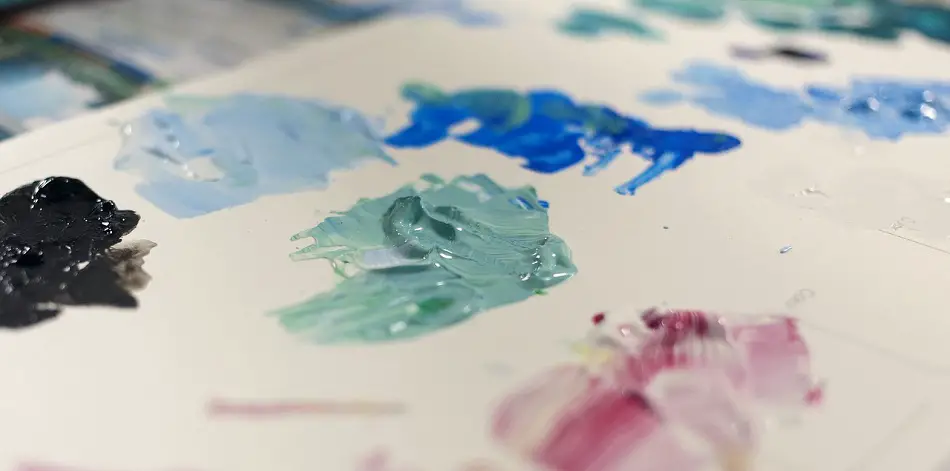Typically people associate stretch canvas with acrylic paint, but paper is an option too! An acrylic painting on paper can be a great way to express your creativity, but you need the right paper for the job.
Can you use acrylic paint on paper? You can use acrylic paint on art paper that is at least 300 GSM (140 lbs) which will prevent warping or buckling. Choose paper made of linen or cotton, not wood pulp which may disintegrate and leave residue or rip during painting. Ensure the paper is 100% acid-free to prevent yellowing or deterioration over time.
Choosing the right paper for acrylic painting can be difficult. There are many different options, and each one has its own set of pros and cons. This blog post will explore four main types of paper available for acrylic painting: canvas paper, multimedia paper, watercolor paper, and acrylic paper. I’ll also answer some common questions about using acrylic paint on these papers so you can make an informed decision about which one is best suited to your needs!
The 4 Paper Options for Acrylic Paint
Canvas Paper
Canvas paper, like canvas, is made from cotton or linen fibers mixed with glue. The primary quality identifying canvas paper from other art papers is the fibrous texture. This texture is visible in your finished project. Also, colors will show more vividly because it is not as absorbent as other papers.
When to Use Canvas Paper
If you want to have texture and a similar effect on your painting as canvas, but you want the portability of paper, use canvas paper!
Pros: Portable, lightweight, relatively inexpensive, vivid colors, similar texture will work with the same techniques as painting on canvas (boards or stretched)
Cons: Tends to warp/curl even at heavier weight; address this with securing the paper while painting/drying to “stretch” it and maintain the proper shape.
Arteza makes this great, inexpensive canvas pad, available on Amazon!

Acrylic Paper
Acrylic paper is similar to canvas paper in that it is textured and thick, but it is more absorbent. This paper is slightly less textured than canvas paper but still offers the “tooth” to grip the paints and allow for maximal adherence.
When to Use Acrylic Paper
If you want to have a textured surface that is more affordable than canvas or even canvas pads, use acrylic paper. Also, if you need more absorbency than canvas but less than watercolor paper, acrylic paper is a good choice. It will allow for some smooth washes but still lovely detail.
Pros: Portable, lightweight, inexpensive, vivid colors, textured, moderately absorbent
Cons: It still warps some, so secure it!
The Strathmore 400 series acrylic pad is affordable and high quality, available on Amazon!

Multimedia Paper
Multimedia is a type of art media that uses a variety of products to create artwork. Because of this, multimedia paper is designed to be very durable and is suitable for use with acrylic, watercolor, pens, pencils, markers, etc.
When to Use Multimedia Paper
Use multimedia paper for when you are practicing techniques, not making “masterpieces.” Also, as the name implies, it is excellent if you mix different media like ink, acrylic, and watercolor all in one piece.
Pros: Inexpensive, useful for most types of artwork
Cons: Typically not as high quality, harder to find in heavier weights (300 GMS or more), tends to curl/warp, especially with more water
I did find this 300 GSM multimedia pad which I was really excited about and have added to my Christmas list! I’ll update this once I try it out!

Watercolor Paper
Watercolor paper is an absorbent paper that is desired for use with watercolor paints. For this reason, high-quality papers are very durable and tolerate a lot of moisture.
When to Use Watercolor Paper
If you are thinning your paints significantly with water and are attempting to achieve an almost watercolor-like effect, go with cold pressed, heavy (300 GSM) watercolor paper. This will allow the absorption and blending similar to that you see in watercolors.
Side note: The benefit of using acrylic this way versus just using watercolors is it dries faster. For those of us who are impatient, that is great! Also, it becomes permanent after drying, so you can layer wet on top of dry paint washes and not worry about affecting the underlayers like you do with watercolor!
Pros: lightly textured, allows for smooth washes and blending, absorbant
Cons: expensive, absorbent (can be a con). To address too much absorbency, apply a layer of gesso to prep the paper.
Arches brand specializes only in watercolor paper, and they are very high quality. I recommend this cold pressed, 300 GSM watercolor paper for use with acrylics as it is more resistant to warping, available on Amazon.

How To Use Acrylic Paint on Paper
To use acrylic paint on paper, ensure you have purchased heavy-weight paper (at least 300 GSM). If it is an art paper, you do not HAVE to prepare it first. If you want less absorbency, apply a thin layer of gesso to the paper, then paint as you usually would with acrylics!
What Paper is Best for Acrylic Painting?
The best paper for acrylic paintings depends on the finished look you are going for. If you want a textured look similar to stretched canvas, purchase a canvas pad like the Arteza Canvas Pad from Amazon. For smooth, blendable washes, go for a watercolor paper like the Arches 300 GSM cold pressed paper.
What is the Difference Between Watercolor and Acrylic Paper?
The main differences between watercolor and acrylic paper are the absorbency levels and the texture. Watercolor paper is more absorbent and has a uniform “bumpy” surface. Acrylic paper is less absorbent and has a linen, threadlike texture.
Watercolor paper is an absorbent, textured surface that will allow for smooth washes and blending. Acrylic paint on watercolor paper looks fantastic if you want a more wet look or have thinned your paints down significantly with water. Know that acrylic paint will dry faster on watercolor paper due to the absorbency, which can make it harder to work with if you aren’t very fast.
Acrylic Paper is not as absorbent but still allows smooth washes of color and blending. It is designed for use with acrylic paints and will allow more working time than working on watercolor paper. The paper still has texture and tooth to allow binding with your pigment, but the surface is more of a linen, threadlike texture.
Is Acrylic Paint Permanent on Paper?
Acrylic paints are permanent when applied to paper. Once they have dried completely, acrylics will not be removable. Because of the permanency, you can layer wet on top of dry and not worry about affecting your prior layers like you do with watercolor painting!
Now that you know the 4 main paper options for acrylic paint and how to use them, it’s time to get started. Get your paints ready! I hope this post has helped you understand how to use acrylic paint on paper. If you have any questions or comments, please feel free to leave a comment below!
Now it is time for YOU to get Crafty with Ashy!
Be sure to subscribe and follow me so you don’t miss any inspiration!


This is an excellent article — clear and comprehensive. This is exactly the thorough response I was hoping to find when I posed my question to the internet about whether to paint with acrylics on paper versus on canvas. (I have been painting with watercolor on paper, and this summer I’m going to experiment with acrylics which I have previously only used on canvas.) Thank you so much for this article. I am grateful!
You’re welcome! Than you for taking the time to leave feedback! I wish you joyful painting!